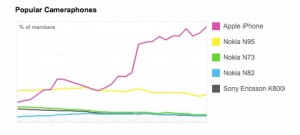We went to a school concert this evening at which a very talented lad played a guitar piece I’d never heard before — Briefly Dreaming of a Night Fly by Pietro Nobile. Afterwards I asked him how he’d come across it. “On YouTube”, he replied. So when I came home I went looking. There are several video performances. Here’s one I liked.
Category Archives: Media ecology
The irresistible rise of the iPhone
Rules of engagement
The best way of ensuring reasonable behaviour in online commenting spaces is to make people responsible for their words. Anonymity prevents that. Of course sometimes anonymity has benefits — especially in repressive environments; but overall it seems to enable the pollution of unmoderated discussions. Mark Anderon has been pondering the question in relation to his blog, and has come up with some rules.
After a year or more of running this blog without rules, we seemed to have recently crossed the Rubicon: in moving from our internal member conversations to a more open, perhaps wild frontier on the Net, the dialogue has gone from that of mutual respect and intellectual exchange to anonymous insult and emotional attack.
So, as of today I am putting the same rules in place on this blog as we use in our newsletter. They are very simple:
1. All comments must be signed, hopefully with real names. Since we are not naive, there is also:
2. Comments should be about issues, and not personal and / or emotional attacks. Fine to say you don’t agree or like something, but say why.
3. We will allow anonymous (to the public) comments in only one situation: when the poster would suffer career damage from the expression of ideas. In these cases, we will require the poster’s real name be shared with us, and we will post the comments anonymously.
In other words: vigorous debate is encouraged, hate mail is not allowed.
Blogs morphing into freesheets. And vice versa
Interesting development.
The Printed Blog, a Chicago start-up, plans to reprint blog posts on regular paper, surrounded by local ads, and distribute the publications free in big cities.
The first issues of this Internet-era penny-saver will appear in Chicago and San Francisco on Tuesday. They will start as weeklies, but Joshua Karp, the founder and publisher, hopes eventually to publish free neighborhood editions of The Printed Blog twice a day in many cities around the country.
How does it work?
The Printed Blog will publish blog posts alongside other Weblike content, like user-submitted photographs and readers’ comments. The paper will be printed on three or four 11-by-17-inch sheets of white paper and laid out like a blog instead of in columns.
Users will eventually be able to log on to its site, theprintedblog.com, to choose which blogs they want in their edition, and editors will decide which posts make the paper. A city the size of Chicago could have 50 separate editions tailored to individual neighborhoods.
The Printed Blog also expects to duck many of the major costs that make traditional newspapers expensive to produce. The company will put commercial printers in the homes of its distributors, avoiding the circulation costs of papers with large, central printing presses. Advertisers will eventually be able to buy ads on the Web site, so The Printed Blog will not need to employ many sales people.
By publishing articles written by bloggers who are already diligently covering topics as varied as town politics and local fashion, Mr. Karp can slash one of the biggest expenses of a newspaper: reporters. So far, 300 bloggers have given The Printed Blog permission to publish their work for a share of the ad revenue, including small-audience bloggers in Chicago and nationally known blogs like Daily Kos.
NYT borrows $250 million
Well, at least they were able to get it.
John Mortimer RIP
John Mortimer, the defence barrister in the trial of Lady Chatterley’s Lover and the creator of Rumpole of the Bailey and much else besides, has died, aged 85.
That missing column
Readers of Roy Greenslade’s blog will have seen that he’s been wondering why Stephen Glover’s column about the decline of the Daily Telegraph was mysteriously pulled from the Independent.
However, Roy helpfully provides a link to the Google cached version, which reads in part:
With so much happening and going wrong, it may seem perverse to dwell on one subject: The Daily Telegraph. I do not apologise. It is no exaggeration to say that what is happening to that paper is a national tragedy. Yet I do not hear questions in Parliament. The leader of Her Majesty’s Opposition does not seem alarmed. The rest of the media, naturally concerned with their own difficulties, seems hardly to notice as this great national institution is being transformed and eviscerated under our very eyes.
I admit I am biased. The Daily Telegraph was the first newspaper I worked for, and it will always have a special place in my heart. It was the paper of the “small c” conservative classes. Of course it changed over the years, as the country changed, but never precipitately. Its circulation fell a little from its 1970s heyday, but unlike some other titles, it was not locked in some apparently irresistible cycle of decline. Then, in 2004, Sir Frederick and Sir David Barclay bought it as Conrad Black, its previous proprietor – and, in my estimation, a pretty good one – was led off first to court, and then to an American jail.
The Barclay brothers love and revere the Daily Mail. And why not? Even its more knowledgeable critics generally concede that it is the most brilliant paper in Britain. But if there is one Mail, why do we need two – especially as the Telegraph lacks the resources, know-how and inspiration to emulate it? Nonetheless, the Barclays – brilliant businessmen, no doubt, though inexperienced publishers – would not be gainsaid. They recruited a chief executive, Murdoch MacLennan, from the Mail group, where he was an expert on presses. In due course, he hired a gaggle of Mail executives, not all of whom, it should be said, were from the paper’s top drawer.
Since then, we have had purge after purge. The Daily Telegraph and its Sunday sister are in a state of permanent revolution. Dozens of the two paper’s best writers and executives have been pushed out. In the last few weeks, A N Wilson, Craig Brown, Joshua Rozenberg, Sam Leith and Andrew McKie have been sent packing. They were not bit-part players. They were the lifeblood of the paper. Slice by slice, the old Telegraph has been dismembered, and what is being put in its place increasingly resembles a weak imitation of the Daily Mail, which, by the way, has picked up several of the Telegraph’s best writers.
The first rule of newspaper ownership and editing is not to discomfort your core readers. Reach out for new ones, of course, but do not forget those who have loyally stuck by the newspaper. The Daily Telegraph’s readers have not been so much discomfited as shaken about like dice. I am sure that the newspaper’s editor, Will Lewis, is highly gifted, but he would scarcely recognise a habitual Telegraph reader if he bumped into one in full daylight. The newspaper’s much-trumpeted digital activities are all well and good, but they are ancillary to what should be the main point: giving traditional Telegraph readers what they expect and want.
The big mystery, of course, is why the Indie would censor a columnist just for going after a rival paper. Roy thinks there’s a bigger story here and he may well be right. But there’s a slightly dated air about it. In the old pre-Web days of media barons and press power this kind of intrigue was a big deal. But now? I don’t think so. As an ageing print hack, I’m interested in this kind of nonsense. But nobody under 30 gives a damn. Nor should they. That world is dying. People are more interested in whether Steve Jobs is terminally ill than in the spectacle of media moguls fighting like cats in a sack.
Life imitating satire

You have to feel sorry for the blogger who was taken in by the Onion’s story about the new keyboardless Mac. The post was redacted, but not before some people captured the page.
49 Amazing Social Media, Web 2.0 And Internet Stats
49 Amazing Social Media, Web 2.0 And Internet Stats. I particularly like these:
133,000,000 – number of blogs indexed by Technorati since 2002
346,000,000 – number of people globally who read blogs (comScore March 2008)
900,000 – average number of blog posts in a 24 hour period
1,750,000 – number of RSS subscribers to TechCrunch, the most popular Technology blog (January 2009)
77% – percentage of active Internet users who read blogs
55% – percentage of the blogosphere that drinks more than 2 cups of coffee per day (source)
81 – number of languages represented in the blogosphere
59% – percentage of bloggers who have been blogging for at least 2 years.
OK, so who’s the biggest security risk, then?
From Wired.com.
For years, members of the military brass have been warning that soldiers' blogs could pose a security threat by leaking sensitive wartime information. But a series of online audits, conducted by the Army, suggests that official Defense Department websites post far more potentially-harmful than blogs do.
The audits, performed by the Army Web Risk Assessment Cell between January 2006 and January 2007, found at least 1,813 violations of operational security policy on 878 official military websites. In contrast, the 10-man, Manassas, Virginia, unit discovered 28 breaches, at most, on 594 individual blogs during the same period.
The results were obtained by the Electronic Frontier Foundation, after the digital rights group filed a lawsuit under the Freedom of Information Act.
"It's clear that official Army websites are the real security problem, not blogs," said EFF staff attorney Marcia Hofmann. "Bloggers, on the whole, have been very careful and conscientious. It's a pretty major disparity." The findings stand in stark contrast to Army statements about the risks that blogs pose.


